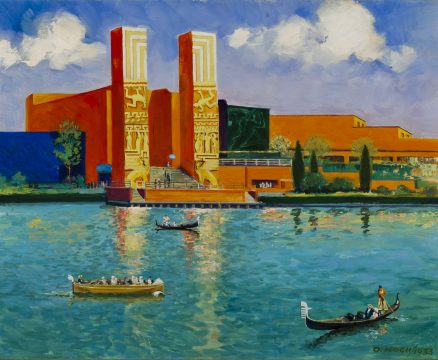- Zoom in on Artwork
- Print Page
- Email Page to Friend
Otto Koch’s strongly colored Electrical Entrance focuses on the Water Gate entrance to the Electrical Building at A Century of Progress, Chicago’s 1933-1934 exposition. An asymmetrical U-shaped structure, the building was the work of New York architect Raymond Hood, while the two monumental pylons flanking the Water Gate bore sculptural reliefs by Lee Lawrie, representing light and sound. The building’s striking black, green, and bright red exterior reflected designer Joseph Urban’s plan for the fair to be a vibrant “Rainbow City,” in contrast to the “White City” of Chicago’s 1893 World’s Columbian Exposition. In Koch’s painting, the Electrical Building glows in the afternoon sun of a summer day. It projects a shimmering reflection onto the rippled surface of the South Lagoon, where an electric launch and two gondolas ferry visitors under a fair-weather sky. The only known painting by Koch, this work reveals considerable facility, suggesting that it was not the artist’s only attempt in the medium.
Koch was one of several artists who produced paintings of the Century of Progress exposition under the name Groh Associates. Like Frank Peyraud’s Afternoon, The Science Palace, World’s Fair, this work bears on the back the Groh Associates stamp and the signatures of its two directors, Edward T. Grigware and Rudolph Ingerle. The latter made his own painting of the subject, Untitled (Electrical Building at Twilight), showing a scene almost identical to Koch’s but from a vantage point slightly to the right. The most striking difference between the two paintings, however, is in the color of the building, a cool white in Ingerle’s image. The bright hues shown by Koch disappeared after the exposition’s 1933 season under a coat of white paint that transformed the fair for its second year.
The Groh Associates’ paintings may have been intended for reproduction in color, for the color photography of the day was inadequate for conveying the vivid tints of the 1933 fair. While the exposition was open in the summer of 1934, the paintings, including Koch’s, were displayed at the Marshall Field and Company department store in an exhibition sponsored by Westinghouse Electric Company, one of the chief suppliers of electricity to the exposition. The paintings’ subjects, noted one reviewer, demonstrated “the attempt…to capture light and its phenomena.”i The paintings were exhibited again in January and in August 1935, as A Century of Progress became the stuff of memory.
Wendy Greenhouse, PhD
Donated by M. Christine Schwartz to the Newberry Library, Chicago, Illinois, in 2021
i C. J. Bulliet, “Around the Galleries: ‘Painting by Light,’” Chicago Daily News, Aug. 25, 1934.
